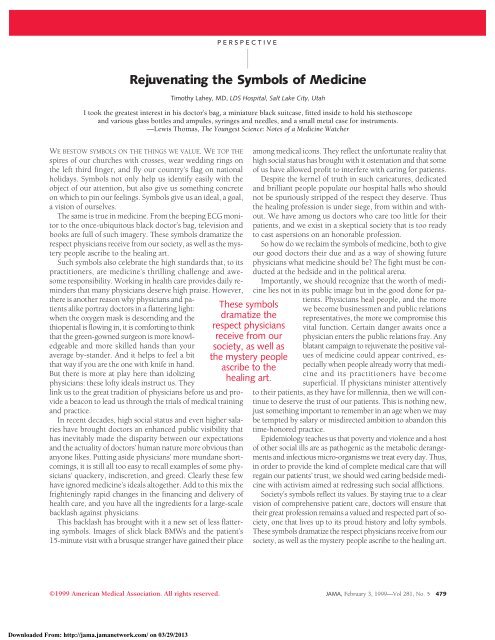JMS0203
JMS0203
JMS0203
Create successful ePaper yourself
Turn your PDF publications into a flip-book with our unique Google optimized e-Paper software.
PERSPECTIVE<br />
Rejuvenating the Symbols of Medicine<br />
Timothy Lahey, MD, LDS Hospital, Salt Lake City, Utah<br />
I took the greatest interest in his doctor’s bag, a miniature black suitcase, fitted inside to hold his stethoscope<br />
and various glass bottles and ampules, syringes and needles, and a small metal case for instruments.<br />
—Lewis Thomas, The Youngest Science: Notes of a Medicine Watcher<br />
WE BESTOW SYMBOLS ON THE THINGS WE VALUE. WE TOP THE<br />
spires of our churches with crosses, wear wedding rings on<br />
the left third finger, and fly our country’s flag on national<br />
holidays. Symbols not only help us identify easily with the<br />
object of our attention, but also give us something concrete<br />
on which to pin our feelings. Symbols give us an ideal, a goal,<br />
a vision of ourselves.<br />
The same is true in medicine. From the beeping ECG monitor<br />
to the once-ubiquitous black doctor’s bag, television and<br />
books are full of such imagery. These symbols dramatize the<br />
respect physicians receive from our society, as well as the mystery<br />
people ascribe to the healing art.<br />
Such symbols also celebrate the high standards that, to its<br />
practitioners, are medicine’s thrilling challenge and awesome<br />
responsibility. Working in health care provides daily reminders<br />
that many physicians deserve high praise. However,<br />
there is another reason why physicians and patients<br />
alike portray doctors in a flattering light:<br />
when the oxygen mask is descending and the<br />
thiopental is flowing in, it is comforting to think<br />
that the green-gowned surgeon is more knowledgeable<br />
and more skilled hands than your<br />
average by-stander. And it helps to feel a bit<br />
that way if you are the one with knife in hand.<br />
But there is more at play here than idolizing<br />
physicians: these lofty ideals instruct us. They<br />
link us to the great tradition of physicians before us and provide<br />
a beacon to lead us through the trials of medical training<br />
and practice.<br />
In recent decades, high social status and even higher salaries<br />
have brought doctors an enhanced public visibility that<br />
has inevitably made the disparity between our expectations<br />
and the actuality of doctors’ human nature more obvious than<br />
anyone likes. Putting aside physicians’ more mundane shortcomings,<br />
it is still all too easy to recall examples of some physicians’<br />
quackery, indiscretion, and greed. Clearly these few<br />
have ignored medicine’s ideals altogether. Add to this mix the<br />
frighteningly rapid changes in the financing and delivery of<br />
health care, and you have all the ingredients for a large-scale<br />
backlash against physicians.<br />
This backlash has brought with it a new set of less flattering<br />
symbols. Images of slick black BMWs and the patient’s<br />
15-minute visit with a brusque stranger have gained their place<br />
These symbols<br />
dramatize the<br />
respect physicians<br />
receive from our<br />
society, as well as<br />
the mystery people<br />
ascribe to the<br />
healing art.<br />
among medical icons. They reflect the unfortunate reality that<br />
high social status has brought with it ostentation and that some<br />
of us have allowed profit to interfere with caring for patients.<br />
Despite the kernel of truth in such caricatures, dedicated<br />
and brilliant people populate our hospital halls who should<br />
not be spuriously stripped of the respect they deserve. Thus<br />
the healing profession is under siege, from within and without.<br />
We have among us doctors who care too little for their<br />
patients, and we exist in a skeptical society that is too ready<br />
to cast aspersions on an honorable profession.<br />
So how do we reclaim the symbols of medicine, both to give<br />
our good doctors their due and as a way of showing future<br />
physicians what medicine should be? The fight must be conducted<br />
at the bedside and in the political arena.<br />
Importantly, we should recognize that the worth of medicine<br />
lies not in its public image but in the good done for pa-<br />
tients. Physicians heal people, and the more<br />
we become businessmen and public relations<br />
representatives, the more we compromise this<br />
vital function. Certain danger awaits once a<br />
physician enters the public relations fray. Any<br />
blatant campaign to rejuvenate the positive values<br />
of medicine could appear contrived, especially<br />
when people already worry that medicine<br />
and its practitioners have become<br />
superficial. If physicians minister attentively<br />
to their patients, as they have for millennia, then we will continue<br />
to deserve the trust of our patients. This is nothing new,<br />
just something important to remember in an age when we may<br />
be tempted by salary or misdirected ambition to abandon this<br />
time-honored practice.<br />
Epidemiology teaches us that poverty and violence and a host<br />
of other social ills are as pathogenic as the metabolic derangements<br />
and infectious micro-organisms we treat every day. Thus,<br />
in order to provide the kind of complete medical care that will<br />
regain our patients’ trust, we should wed caring bedside medicine<br />
with activism aimed at redressing such social afflictions.<br />
Society’s symbols reflect its values. By staying true to a clear<br />
vision of comprehensive patient care, doctors will ensure that<br />
their great profession remains a valued and respected part of society,<br />
one that lives up to its proud history and lofty symbols.<br />
These symbols dramatize the respect physicians receive from our<br />
society, as well as the mystery people ascribe to the healing art.<br />
©1999 American Medical Association. All rights reserved. JAMA, February 3, 1999—Vol 281, No. 5 479<br />
Downloaded From: http://jama.jamanetwork.com/ on 03/29/2013



